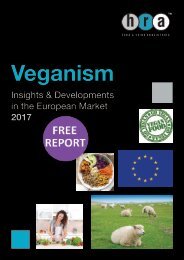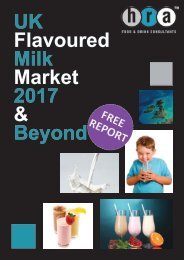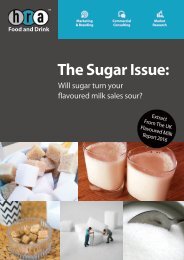FREE-UK-Flavoured-Milk-Report-2016-2017
The backdrop to the UK flavoured milk market is one of relentless change. The removal of the EU milk quotas, the transition to a Western-type diet by emerging economies, the UK sugar debate and the booming sports nutrition industry are all aspects of change that create both challenges and opportunities for the UK flavoured milk market. HRA Food and Drink Marketing has developed this report as a map to guide industry stakeholders. Although volume growth in 2014 was slightly lower than in previous years, the flavoured milk market still has plenty of room for product innovation and development. Overall, we expect the UK flavoured milk market to continue to grow over the medium term, but not without improving its nutritional profile. The sugar debate reached new heights when, in October 2015, Public Health England released a document suggesting Government intervention in the form of a sugar tax (levy). As a consequence, product reformulation has become a priority for all serious players in the market.
The backdrop to the UK flavoured milk market is one of relentless change. The removal of the EU milk quotas, the transition to a Western-type diet by emerging economies, the UK sugar debate and the booming sports nutrition industry are all aspects of change that create both challenges and
opportunities for the UK flavoured milk market.
HRA Food and Drink Marketing has developed this report as a map to guide industry stakeholders. Although volume growth in 2014 was slightly lower than in previous years, the flavoured milk market still has plenty of room for product innovation and development.
Overall, we expect the UK flavoured milk market to continue to grow over the medium term, but not without improving its nutritional profile. The sugar debate reached new heights when, in October 2015, Public Health England released a document suggesting Government intervention in the form of a sugar tax (levy). As a consequence, product reformulation has become a priority for all serious players in the market.
Create successful ePaper yourself
Turn your PDF publications into a flip-book with our unique Google optimized e-Paper software.
<strong>UK</strong>#FLAVOURED#MILK#<strong>2016</strong>217#<br />
#<br />
To Gain Access<br />
Purchase The Full<br />
<strong>Report</strong> Now<br />
Figure 2-2: This chart does not specifically represent the brands<br />
featured. The selected brands are a visual guide as they are the most<br />
well known in each sub-category.<br />
Although the sub-categories are presented as mutually exclusive, they are<br />
not necessarily so. Increasingly, more products are converging and breaking<br />
out of their sub-category and some of the boundaries are blurring.<br />
•#<br />
•#<br />
•#<br />
•#<br />
•#<br />
Traditional flavoured milk occupies almost half of the entire flavoured<br />
milk offer and centres around the traditional flavours of vanilla, strawberry<br />
and chocolate.<br />
Functional drinks are the second largest category with an estimated<br />
quarter of the supply.<br />
Coffee is the third most popular To category Gain Access and almost all other categories<br />
are attempting to include coffee Purchase a flavour The in order Full to expand their<br />
range since the segment is seeing <strong>Report</strong> strong performance. Now<br />
Confectionary, defined as flavoured milk usually offered in an indulgent<br />
flavour because of its sweet, creamy and rich texture is an estimated 10%<br />
of the category.<br />
Breakfast and dairy-alternatives are still a small section of the flavoured<br />
milk market, but they are both fast growing.<br />
2.6 Own Label<br />
One of the brakes that has hampered own label development in the category<br />
is the availability of appropriate bottling capacity for own label propositions.<br />
Whilst the retailers have well-developed liquid milk pools so would be able to<br />
divert milk to flavoured milk production, the lack of <strong>UK</strong> bottling capacity has<br />
acted to restrain own label growth. This is a particular constraint on their<br />
ability to develop UHT products which are usually manufactured on the<br />
continent due to the lack of capability on the <strong>UK</strong> mainland.<br />
# 25#<br />
All rights reserved, ©Teepee#Ltd,#t/a#HRA#Food#&#Drink:#<strong>2016</strong>#<br />
to#<strong>2017</strong>#







